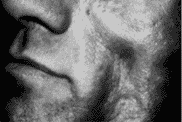Back to Web version of article
 |
Sign a petition to improve access to facial lipoatrophy treatments through Medicare — and read on for more information.
The road to regaining a healthy look for people affected by HIV-associated facial lipoatrophy has been a long one. Improvements have come, but challenges are still here. Most people in the United States still do not have access, 7 years after the approval of the first product for this disfiguring problem.
Since the first reports of the drastic disappearance of fat under the skin in HIV-positive people taking D4T (Zerit) or AZT in 1998, the community started experimenting with poly-L-lactic acid (called New-Fill in those days) imported from France. An HIV-positive doctor there had used this nonpermanent substance to illicit collagen formation on his and his patients’ faces.
The French manufacturers sold the rights to a large company (Aventis) and this company gathered data for FDA approval of this product for facial lipoatrophy. Most of the data had been generated by three doctors who were using the imported product with the help of their activist patients.
FDA approval came on August of 2004 with a new name: Sculptra. The product was priced at $1,000 per session, plus $400-$600 for doctor’s injection fees. Depending on the severity of their facial wasting, patients would need 3 to 7 sessions, with yearly touch ups (this product helps faces gain collagen but it is not a permanent option).
Activists ensured that the expensive product would be provided for free for patients with yearly incomes of under 40K (higher for patients with dependants). Patients still have to pay $300-$600 dollars per session for doctor’s fees out of their own pockets. This made access still limited even for those who qualified for free product.
Radiesse, made by Merz Aesthetics, was the second product approved for HIV facial lipoatrophy. It is as expensive and non permanent as Sculptra, and with a more limited patient assistance program that provides discounts (not free product) for those who qualify due to income.
It took 6 years of activism to get Medicare to gather public comments for approval. Medicare approved payments for Sculptra and Radiesse (plus doctor’s fees) in January of 2010.
However, the cost of acquiring and administering the product is higher than the payment amount set by Medicare. As a result, physicians are not accepting Medicare payments for this service, and patient access to these effective therapies remains quite limited at the current reimbursement rates. In 2010 the Medicare allowance for an injection fee was set at 80% of $99-$115 (depending on which part of the country the service is administered). The procedure typically takes between 45 to 60 minutes of surgery by a trained physician required to administer Sculptra and/or Radiesse. This is making it unaffordable and impractical for HIV specialists, dermatologists, or plastic surgeons to administer this treatment.
To make matters worse, both Aventis and Merz have already started to limit their patient assistance programs since Medicare’s approval, which has left some patients in a bind since they cannot find doctors who would bill Medicare; and the companies tell them that they no longer can help them since Medicare pays for the products and procedure. So, access to these products has gotten worse, not better, after January of 2010.
Now we are asking for your help to sign this petition to be sent to Medicare to have them increase the rates for administering the products to patients.
Please forward it to your physician and friends. The deadline to sign is April 24, 2011.
I will write a blog entry with an update after I hear from Medicare.
Send Nelson an e-mail.


